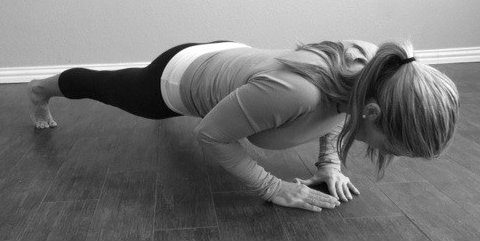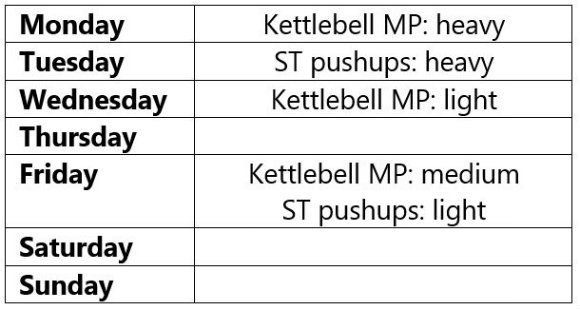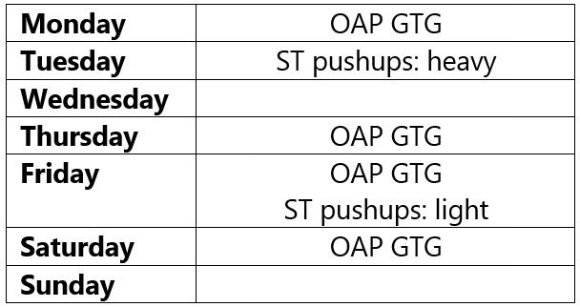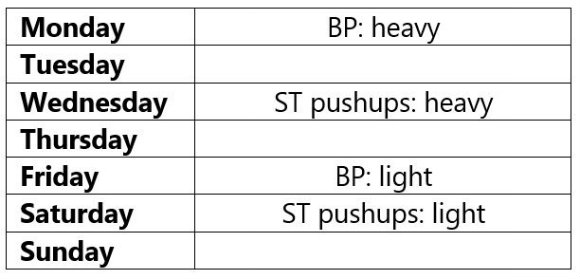Note: This article continues the series started in Should You Build Your Slow Fibers? and continued in How to Build Your Slow Fibers, Part I.
Today I will present you with a plan that will increase your pressing strength and endurance by building up slow muscle fibers in your triceps. The plan may be used in conjunction with any type of press — the kettlebell military press, the one-arm pushup, the barbell bench press, etc.

Pressing Strength Plan Guidelines
- Carry on your regular press training — low reps and multiple sets aimed at neural adaptations and fast fiber hypertrophy.
- The exercise is a diamond push-up done in a particular manner: thumbs and index fingers of both hands touching, hands under the sternum, slow constant tension movement in the middle third of the range of motion.
- All sets must be done to failure, which must occur in thirty to sixty second — no more, no less. Raise your hands or feet if necessary to adjust the resistance accordingly.
- Do not hold your breath — “breathe behind the shield.”
- The first minute after each set shake the muscles you just worked — swing your arms, shadow box, massage your triceps, etc. to reduce the congestion as quickly as possible! It is essential for the program’s success.
- A minimal rest between sets is five minutes. This number is not negotiable and a longer rest of ten minutes is preferable. You may do other exercises during that time. Or you may choose the grease-the-groove (GTG) tactic and spread your sets throughout the day. One can do push-ups anywhere.
- Do your slow push-ups to failure twice a week, a high volume day and a low volume day. Perform the following number of sets:
 On the heavy push-up day you may train as usual — grinds and ballistics — except for presses. Do no presses of any kinds, including get-ups. You may train heavy presses the day after, but not hard.
On the heavy push-up day you may train as usual — grinds and ballistics — except for presses. Do no presses of any kinds, including get-ups. You may train heavy presses the day after, but not hard.
Sample Weekly Schedule
Following is a sample weekly schedule fitting the Rite of Passage kettlebell press plan. As an option, the light push-up session may be moved to Saturday.
 And here is a schedule for an athlete training the one-arm push-up (OAP) in the GTG manner:
And here is a schedule for an athlete training the one-arm push-up (OAP) in the GTG manner:
 Finally, a schedule for a lifter bench pressing twice a week:
Finally, a schedule for a lifter bench pressing twice a week:
 On week seven or eight, test your press strength, using the press of your choice. Ten minutes later test your push-ups reps. You need a baseline of both coming into the program.
On week seven or eight, test your press strength, using the press of your choice. Ten minutes later test your push-ups reps. You need a baseline of both coming into the program.
Next time, we will discuss the pros and cons of training both the FT and the ST fibers in all muscle groups along with the guidelines for doing it. Until then, pressing power to you!
Read more:
How to Build Your Slow Fibers, Part I
How to Build Your Slow Fibers Part III





Hmm crazy thought. Can you superset ST squats with an ST press? Im thinking doing a set of squats. Rest five minutes. Doing a set of ST pushups/dumbell military press/ incline dumbell press. Rest five minutes. Repeat until the set number of sets are done. Is this viable?
…other than the aforementioned tricep, sorry ! Thanks
Interesting article, thank you !
Can we deduce then that this type of training can be used to develop the calf muscle(s) ? If so, would that mean refraining from doing heavy squats after a heavy calf ST hypertrophy training ?
My inference might be misplaced but I’m pretty sure the calfs will be burning like hell.
One final question, what slow twitch muscles other than the legs, if any, can truly benefit from this training ? Thank you
Can you still practice TGU’s on the Saturday variety day?
Pavel, do you think using the MP and ST template from this article but with the DeLorme method chains rather than ETK ladders is plausible?
I’m often guilty of smashing two awesome programs together to be left with scrap and shrapnel.
I want to voice my appreciation for this program. It’s convenient and easy to combine with other programs. I just finished week 5. My triceps have grown and I am feeling significantly stronger with pressing. Awesome.
Would a second cycle of this program be beneficial or is it a matter of diminishing returns?
Good job, Lsasl!
Go for a second cycle—and then maintain for awhile.
Mr Tsatsouline, thank you very much for this information graciously offered for free. Can I please confirm whether heavy bag boxing work or resistant control and restraint drills would count as a press in the sense of something to be avoided following a heavy slow pushup day? Thanks again for your kind help.
Steve, that is OK.
Is training the ST muscles a good way to prepare for the Snatch Test and other SFG cert tests?
Victor, it can, but programming will be difficult. I suggest you stick with a proven preparation plan, e.g. Brett Jones’.
sorry a stupid question, so when doing the press up you start from the elbows locked position move down over say 20 seconds (don’t touch the floor) then raise back up over 20 seconds. At which point should failure occur?
Or does the 1/3 range mean holding the pressup in the middle until you collapse? sorry I must be miss reading this.
Paul,
Obviously I’m not Pavel, but the idea is to move through partial reps in only the middle third of the movement. So do pushups except you never go all the way up nor all the way down, and keep repeating slowly until you can’t do any more.
thanks Joe
Pavel,
Thank you for your previous responses. Is it safe to assume that since the ROP schedule and the modified Delorme schedule are the same that the heavy ST days can follow the ROP schedule as stated above?
Thanks – Joe
What does “breathe behind the shield” mean? Also what would be the best breathing techniques to use (for exercises such as squats and bench presses as well as exercises requiring you to move under load, like the farmers walk?) thanks
Hello,
i have a question about this exercise, i read that after 7-8 sec into muscle contracture, there is no more oxygen in the torso muscle and so after this delay the endurance objective is no more achieved, you have to keep short relaxation to restore oxygen. So, do you train your slow fibers if you keep your torso muscle contracted during 30-60 s without relaxation?
thanks
Jean, not getting oxygen to them is exactly the point in this type of training.
Thanks Pavel, i have some lack or knowledge, i ll fix that.
great pavel , sir any new books coming out writen by you
Thanks, Noe!
I have some books in the works but right now I am focused on Plan Strong.
Loved this article series. If i am currently doing the 40 day plan with weighted pushups as my press movement would i be better of doing this after completing that due to the frequency?
Ryan, yes, wait until after.
Will do. Thanks for the reply!
Is there a recommended lower body protocol/exercise? I’m guessing a squat or leg press at the previously recommended 30%-70% 1RM to create failure in the 30-60 sec time.
However, given that the upper body exercise recommended is a specific type of pushup, I’m wondering if there is an alternate, specific lower body exercise, as well.
CC, yes, pick a squat that works for you.
Mr.Tsatsouline, will be there a plan for squats in part 3 ?
Carl, no, but you can apply the same numbers. The only difference is, you will have to overhaul the rest of yoru training because squats are so demanding.
Maybe I will do them in different session in the same day, I will experiment. Thank you for the answer,sir!
I really like the whole series about ST muscles! Pavel, do you think this will work well combined with other hypertrophy oriented program like Total tension? Or would those two interfere?
Good afternoon Pavel, if I’m doing 1H swings and getups on Tuesdays and Thursdays per the ROP schedule(only with a bell I own), do I decrease the ST high volume day sets at all and can I do them right after getups, or should I push that training to later on in the day with or without decreasing number of sets? I get that I’m in a different ROM for the elbow and the shoulder between the two sessions, but wasn’t sure if you felt that putting the ST high volume on the same day as getups, even if “light”, might be too much for the triceps.
Many thanks,
Joe
Joe, I would do it the next day.
Thank you sir. I re-read the article and see that you stated it plainly. I skipped my TGUs and did the 4 sets instead. Wow is all I can say. And surprisingly (to me) this morning’s light ladders didn’t feel any harder. I went ahead and tried it for biceps also with dumbbell curls. I realized that I needed to be able to plan to fail so by using dumbbells I wouldn’t hit myself with a bar or hyperextend my elbows on a preacher. Even doing them yesterday my chins this morning felt no harder. This is pretty amazing.
Call me show but I’m super confused. A video would be great.
Would be great to run us through a full workout.
Big fan!!
What perfect timing! I am starting RoP in March in preparation for the Spring TSC. Although there is no press in the TSC, I can’t imagine this protocol hindering any of the events. Looking forward to it!
For the slowly thinking among us – for me: is the time 30 – 60 sec. the duration of one rep? Does the set consist of one rep only?
Thanks and regards!
Sergej
My understanding is that it’s max reps in this time. If you can keep going past 60 seconds you need to make it harder, and if you max out before 30 seconds you need to make it easier.
I don’t know that “max reps” is the best way to put it, because the idea is slow movement and max reps might imply trying to cram as many as possible into the time.
“slow constant tension movement in the middle 1/3 of the range of motion”
In Part 1 of this series Pavel suggests a “super slow, non-lockout”. I am going to choose to do these in a 4-2-4-2 count. 4 seconds down from the top (although the top will not be locked out at the elbows), 2 second pause in the bottom, 4 count up to top (again, not locked out), 2 count pause. I think I’ll probably hit anywhere from 3-8 reps in a set, and I think I’ll be smoked!
Sergej, it is the duration of a set. How many reps you will do in that time frame does not matter; just keep moving slowly.
Thank you Pavel!
Before you answered I tried to do one push up in a minute. Well… was to hard.
But one push up in 40-45 seconds worked well.
So I did two of them watching the form and the tension. At the 3d rep it became shaky, so I canceled the rep.
Did it make any sence to work that slow? Or would it be better to make it like Sam McLean wrote above: 4-2-4-2 count?
I’m not yet sure, if I’ll be able to combine this protokoll with my actual programm.
After reading all your books and trying the things out in last two years and, of course, taking my old injuries in account I came now, being 42, to a mix of RoP and S&S. They compliment each other and deliever WTH effects all the time.
Actally I’ve mastered the 24 KB in S&S in prescribed time. The weak link was the swing. In TGU I’ve allready started to work with 28 KB. But now I’ll make a step back and will work with the 24 KB until I’ll really dominate it in swing. In RoP I’m repeating the 1-2-3 ladders this week.
Best regards!
Sergej, the exact tempo does not matter as long it is slow enough to cancel any momentum.
Thank you!
RoP with 28 KB – I forgot! 😉
Fascinating stuff, and I really like that this is a program that can easily be done while traveling. Can this be combined with a higher-frequency method such as PTTP, or would you counsel against mixing those two?
Chris, yes, it can.